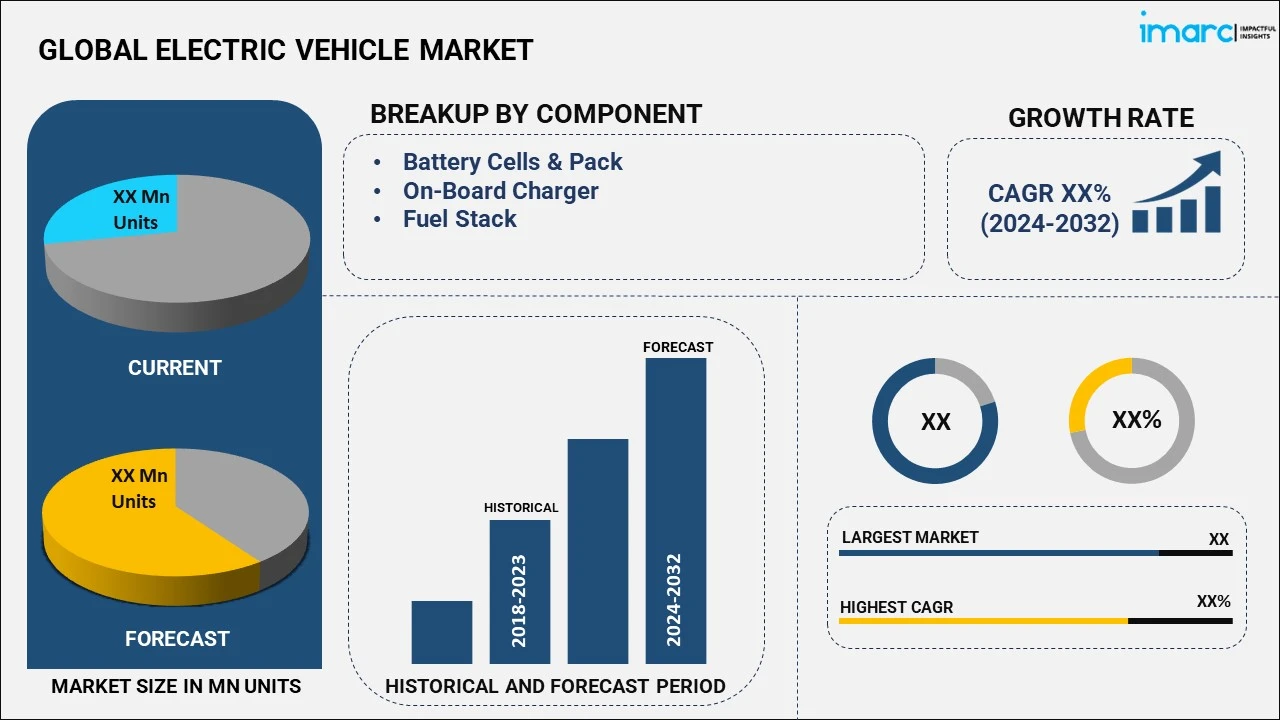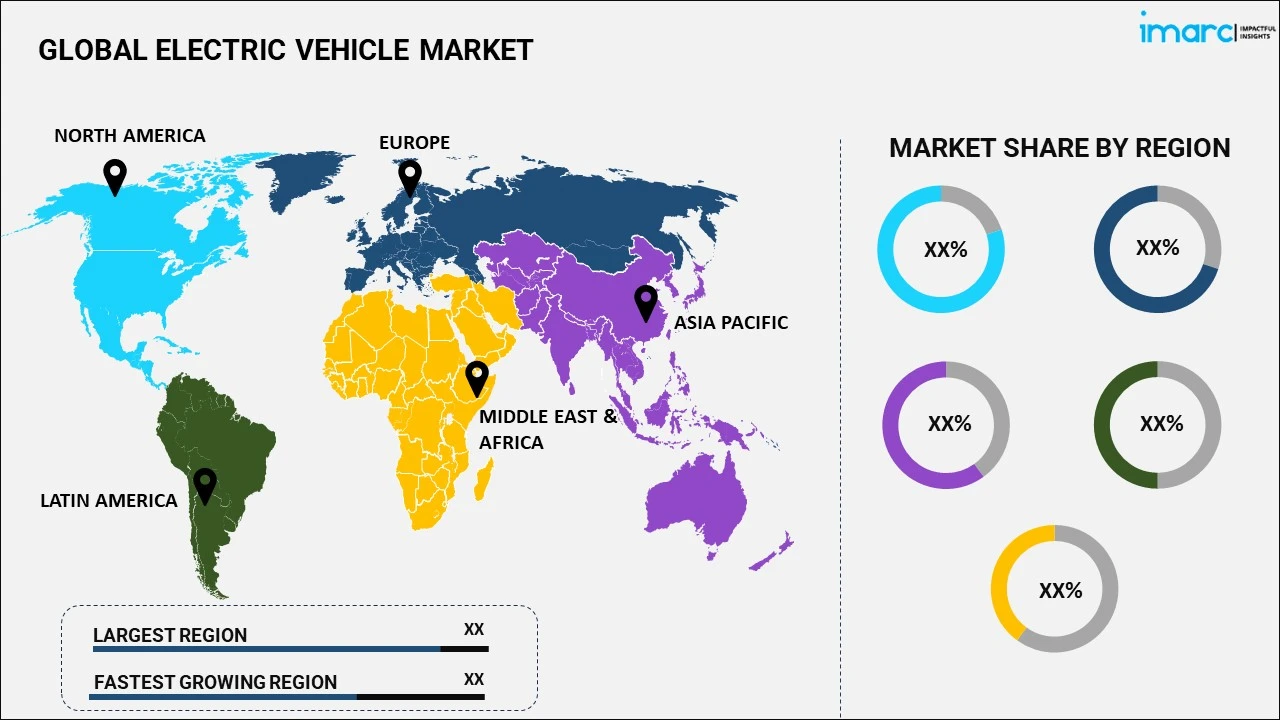
Electric Vehicle Industry Segmentation
EV Market Statistics for 2024-2032: Electric Vehicle Industry Segmentation Report by IMARC Group.
Dive into the comprehensive segmentation of the global electric vehicle (EV) market with IMARC Group's detailed report. This extensive analysis covers the key trends within each market segment, offering forecasts on the global, regional, and country levels from 2024 to 2032.
Electric Vehicle Industry Segmentation:
IMARC Group provides an analysis of the key trends in each segment of the global electric Vehicle market report, along with forecasts at the global, regional and country levels from 2024-2032. Our report has categorized the market based on component, charging type, propulsion type and vehicle type.
The global electric vehicle market size reached US$ 618.9 Billion in 2023. Looking forward, IMARC Group expects the market to reach US$ 4,918.7 Billion by 2032, exhibiting a growth rate (CAGR) of 22.1% during 2024-2032. The increasing concerns over environmental sustainability, the need to reduce emissions, advancements in battery technology, supportive government policies and incentives, growing public awareness, and investments in renewable energy sources are few of the factors accelerating the market growth.
Breakup by Component:

- Battery Cells & Packs
- On-Board Charger
-
Fuel Stack
The report has provided a detailed breakup and analysis of the market based on the component. This includes battery cells and packs, onboard chargers, and fuel stacks.
The key drivers for the battery cells & packs segment in the electric Vehicle market include advancements in battery technology, leading to improved energy density and range, and increased investments in research and development. Additionally, supportive government policies and growing demand for electric Vehicle are stimulating the demand for efficient battery solutions. The on-board charger segment is driven by the expanding electric vehicle infrastructure, with governments and private companies investing in charging networks. Moreover, technological innovations are enhancing charging efficiency and reducing charging times, while automakers' focus on seamless integration of chargers in EVs is boosting the segment's growth. The fuel stack segment is primarily driven by the development of hydrogen fuel cell technology and its potential as a clean energy source for electric Vehicle. Investments in fuel cell research and government initiatives promoting fuel cell Vehicle are key factors propelling the growth of this segment in the electric Vehicle market.
Breakup by Charging Type:
- Slow Charging
-
Fast Charging
Slow charging holds the largest share in the market
A detailed breakup and analysis of the market based on the charging type has also been provided in the report. This includes slow charging and fast charging. According to the report, slow charging represented the largest segment.
The slow charging segment in the global electric Vehicle market is driven by various factors. Slow charging systems are typically more cost-effective and easier to install, making them attractive for home users and small-scale charging stations. The lower power demand reduces strain on the existing electrical grid, facilitating integration without significant infrastructure upgrades. Additionally, slow charging is generally considered to be gentler on EV batteries, potentially extending their lifespan and efficiency. This type of charging can be more suitable for overnight charging or when Vehicle are parked for extended periods, such as at workplaces or residential areas. Public policies and incentives that encourage energy conservation may also promote the use of slow charging. Overall, factors like affordability, ease of installation, compatibility with existing infrastructure, battery health considerations, and alignment with energy conservation goals collectively contribute to driving the slow charging segment in the global EV market.
Breakup by Propulsion Type:
- Battery Electric Vehicle (BEV)
- Fuel Cell Electric Vehicle (FCEV)
- Plug-In Hybrid Electric Vehicle (PHEV)
-
Hybrid Electric Vehicle (HEV)
Hybrid electric vehicle (HEV) dominates the market
The report has provided a detailed breakup and analysis of the market based on the propulsion type. This includes battery electric vehicle (BEV), fuel cell electric vehicle (FCEV), plug-in hybrid electric vehicle (PHEV), and hybrid electric vehicle (HEV). According to the report, hybrid electric vehicle (HEV) represented the largest segment.
The hybrid electric Vehicle (HEVs) segment is witnessing significant growth, driven by the stringent emissions regulations and environmental concerns. HEVs offer a bridge between traditional internal combustion engines and fully electric Vehicle, providing lower emissions and improved fuel efficiency, making them an attractive choice for environmentally conscious consumers. Additionally, advancements in hybrid technology have resulted in more sophisticated and efficient powertrain systems, enhancing the overall performance and driving experience of HEVs. Furthermore, rising fuel prices have motivated consumers to seek fuel-efficient alternatives, and HEVs fit the bill by combining an internal combustion engine with electric propulsion. In line with this, governments worldwide are offering incentives and subsidies to promote HEV adoption, further stimulating the market growth. Moreover, the growing awareness of sustainable mobility solutions and the increasing demand for green transportation options contribute to the expansion of the HEV segment.
Breakup by Vehicle Type:
- Passenger Vehicle
- Commercial Vehicle
-
Others
Passenger Vehicle hold the largest share in the market
A detailed breakup and analysis of the market based on the vehicle type has also been provided in the report. This includes passenger Vehicle, commercial Vehicle, and others. According to the report, passenger Vehicle represented the largest segment.
The passenger Vehicle segment is witnessing significant growth, primarily driven by the evolving consumer preferences and lifestyle changes. Moreover, rapid urbanization and increasing disposable incomes in emerging economies are fueling the desire for personal mobility, leading to higher car ownership rates. In line with this, technological advancements in the automotive industry, such as autonomous driving capabilities, connected car features, and electric mobility solutions, are attracting consumers and driving innovation in passenger Vehicle. Additionally, stringent emission regulations and sustainability concerns are encouraging automakers to invest in electric and hybrid passenger cars, contributing to market expansion. Furthermore, favorable financing options and low-interest rates are making car ownership more accessible to a broader population. Besides this, the growing popularity of ride-sharing and car-sharing services is transforming the way consumers perceive car ownership, influencing their decisions in the passenger Vehicle segment.
Breakup by Region:

-
Asia Pacific
- China
- Japan
- India
- South Korea
- Australia
- Indonesia
- Others
-
Europe
- Norway
- Netherlands
- Sweden
- United Kingdom
- France
- Germany
- Others
-
North America
- United States
- Canada
-
Middle East and Africa
- Turkey
- Saudi Arabia
- Iran
- United Arab Emirates
- Others
-
Latin America
- Brazil
- Mexico
- Argentina
- Colombia
-
Others
Asia Pacific exhibits a clear dominance, accounting for the largest electric Vehicle market share
The report has also provided a comprehensive analysis of all the major regional markets, which include North America (the United States and Canada); Europe (Norway, Netherlands, Sweden, the United Kingdom, France, Germany, and others); Asia Pacific (China, Japan, India, South Korea, Australia, Indonesia, and others); Latin America (Brazil, Mexico, Argentina, Colombia, and others); and the Middle East and Africa (Turkey, Saudi Arabia, Iran, United Arab Emirates, and others). According to the report, Asia Pacific accounted for the largest market share.
The Asia Pacific region is witnessing a surge in electric vehicle adoption, fueled by the region's strong commitment to environmental sustainability and reducing air pollution, which has led governments to implement stringent emissions regulations and ambitious targets for electric vehicle penetration. In line with this, rapid urbanization and population growth in many Asian countries have heightened concerns over congestion and air quality, prompting a shift towards electric mobility as a viable solution. Besides this, advancements in battery technology, coupled with increasing investments in research and development, have bolstered the performance and affordability of electric Vehicle, making them a more attractive option for consumers. Moreover, supportive government policies and incentives, including tax incentives, subsidies, and infrastructure development, are accelerating EV adoption across the region. Additionally, a burgeoning middle class with increasing disposable income is driving demand for personal transportation, and electric Vehicle offer an environmentally friendly choice. Furthermore, strategic partnerships and collaborations between automakers, technology firms, and governments are facilitating the growth of charging infrastructure, addressing range anxiety concerns and promoting electric vehicle accessibility.
Electric Vehicle Market Report Snapshots :
Need more help?
- Speak to our experienced analysts for insights on the current market scenarios.
- Include additional segments and countries to customize the report as per your requirement.
- Gain an unparalleled competitive advantage in your domain by understanding how to utilize the report and positively impacting your operations and revenue.
- For further assistance, please connect with our analysts.

 Inquire Before Buying
Inquire Before Buying
 Speak to an Analyst
Speak to an Analyst
 Request Brochure
Request Brochure
 Request Customization
Request Customization




.webp)




.webp)












